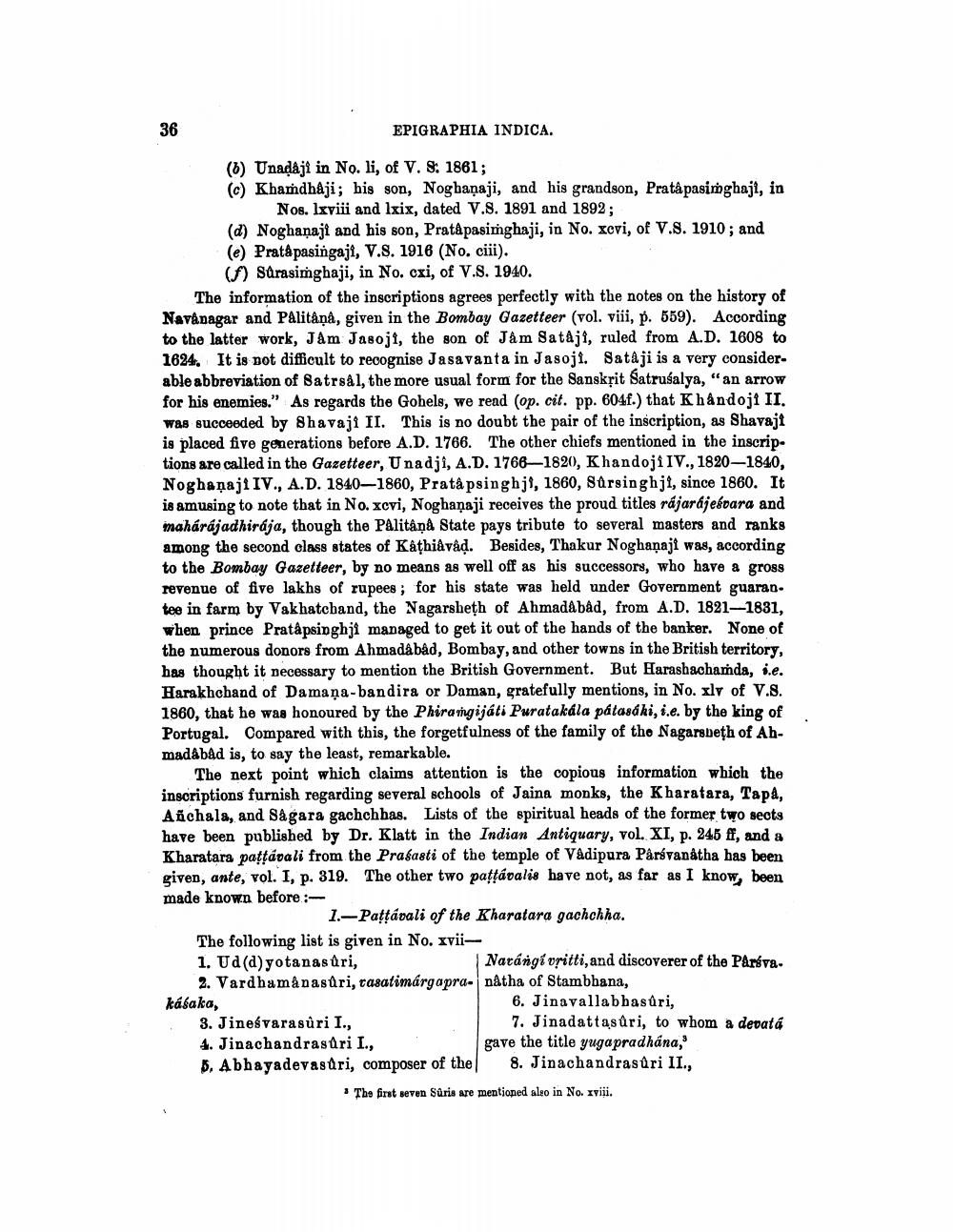________________
EPIGRAPHIA INDICA.
(6) Unadaji in No. li, of V. 8. 1861; (c) Khamdhaji; his son, Nogbaņaji, and his grandson, Pratâ pasimghajt, in
Nos. lxviii and lxix, dated V.8. 1891 and 1892; (d) Noghanaji and his son, Pratápasimghaji, in No. xevi, of V.8. 1910; and (e) Prata pasingaji, V.8. 1916 (No. ciii).
(f) Sarasimghaji, in No. cxi, of V.S. 1940. The information of the inscriptions agrees perfectly with the notes on the history of Navânagar and Pálitânå, given in the Bombay Gazetteer (vol. viii, p. 559). According to the latter work, Jam Jasoji, the son of Jam Sataji, ruled from A.D. 1608 to 1624. It is not difficult to recognise Jasavanta in Jasoji. Sataji is a very considerable abbreviation of Batrsål, the more usual form for the Sanskpit Satrusalya, "an arrow for his enemies." As regards the Gohels, we read (op. cit. pp. 604f.) that Khandoji II. was succeeded by Shavaji II. This is no doubt the pair of the inscription, as Shavaji is placed five generations before A.D. 1766. The other chiefs mentioned in the inscriptions are called in the Gazetteer, U nadji, A.D. 1766—1820, Khandoji IV., 1820-1840, Noghanaji IV., A.D. 1840—1860, Pratåpsinghji, 1860, Sûrsinghji, since 1860. It is amusing to note that in No.xcvi, Noghaņaji receives the proud titles rájarájeśvara and maharajadhiraja, though the PAlitan State pays tribute to several masters and ranks among the second class states of Kathiåvåd. Besides, Thakur Noghanaji was, according to the Bombay Gazetteer, by no means as well off as his successors, who have a gross revenue of five lakhs of rupees; for his state was held under Government guaran. tee in farm by Vakhateband, the Nagarsheth of Ahmadabad, from A.D. 1821-1831, when prince Pratápsinghji managed to get it out of the hands of the banker. None of the numerous donors from Ahmadabad, Bombay, and other towns in the British territory, has thought it necessary to mention the British Government. But Harashachanda, óe. Harakhchand of Damaņa-bandira or Daman, gratefully mentions, in No. xlv of V.S. 1860, that he was honoured by the Phirangijáti Puratakála pátasáki, i.e. by the king of Portugal. Compared with this, the forgetfulness of the family of the Nagarsbeth of Ahmadabad is, to say the least, remarkable.
The next point which claims attention is the copious information which the inscriptions furnish regarding several schools of Jaina monks, the Kharatara, Tapa, Aichala, and Sågara gachchhas. Lists of the spiritual heads of the former two sects have been published by Dr. Klatt in the Indian Antiquary, vol. XI, p. 245 ff, and a Kharatara pattávali from the Prasasti of the temple of Vadipura Pårávanátha has been given, ante, vol. I, p. 319. The other two pattávalis have not, as far as I know, been made know.n before :
1.- Pattávali of the Kharatara gachchha. The following list is given in No. xvii1. Ud(d)yotanasuri,
Narangi vritti, and discoverer of the Parýva. 2. Vardhamanasuri, tasatimárgapra- nátha of Stambhana, kábaka,
6. Jinavallabhasůri, 3. Jinesvarasůri I.,
7. Jinadattasari, to whom a devata 4. Jinachandrasari I.,
gave the title yugapradhana, . Abhayadevasari, composer of the 8. Jinachandrasuri II,
• The first seven Sûris are mentioned alo in No. xviii.




